CompletableFuture进阶篇-外卖商家端API的异步化
背景
随着订单量的持续上升,美团外卖各系统服务面临的压力也越来越大。作为外卖链路的核心环节,商家端提供了商家接单、配送等一系列核心功能,业务对系统吞吐量的要求也越来越高。而商家端API服务是流量入口,所有商家端流量都会由其调度、聚合,对外面向商家提供功能接口,对内调度各个下游服务获取数据进行聚合,具有鲜明的I/O密集型(I/O Bound)特点。在当前日订单规模已达千万级的情况下,使用同步加载方式的弊端逐渐显现,因此我们开始考虑将同步加载改为并行加载的可行性。
为何需要并行加载
外卖商家端API服务是典型的I/O密集型(I/O Bound)服务。除此之外,美团外卖商家端交易业务还有两个比较大的特点:
- 服务端必须一次返回订单卡片所有内容:根据商家端和服务端的“增量同步协议注1”,服务端必须一次性返回订单的所有信息,包含订单主信息、商品、结算、配送、用户信息、骑手信息、餐损、退款、客服赔付(参照下面订单卡片截图)等,需要从下游三十多个服务中获取数据。在特定条件下,如第一次登录和长时间没登录的情况下,客户端会分页拉取多个订单,这样发起的远程调用会更多。
- 商家端和服务端交互频繁:商家对订单状态变化敏感,多种推拉机制保证每次变更能够触达商家,导致App和服务端的交互频繁,每次变更需要拉取订单最新的全部内容。
在外卖交易链路如此大的流量下,为了保证商家的用户体验,保证接口的高性能,并行从下游获取数据就成为必然。

并行加载的实现方式
并行从下游获取数据,从IO模型上来讲分为同步模型和异步模型。
同步模型
从各个服务获取数据最常见的是同步调用,如下图所示:
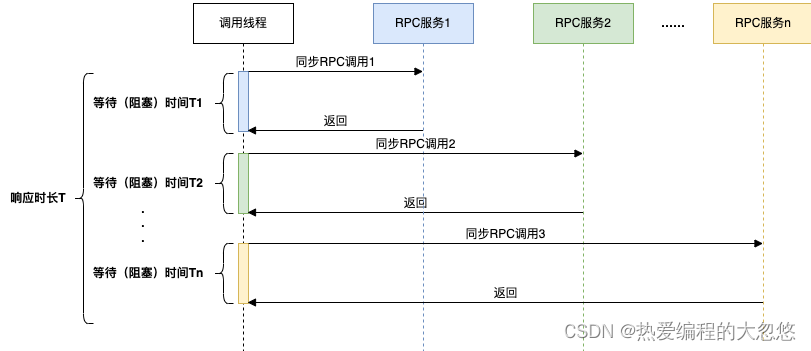
在同步调用的场景下,接口耗时长、性能差,接口响应时长T > T1+T2+T3+……+Tn,这时为了缩短接口的响应时间,一般会使用线程池的方式并行获取数据,商家端订单卡片的组装正是使用了这种方式。
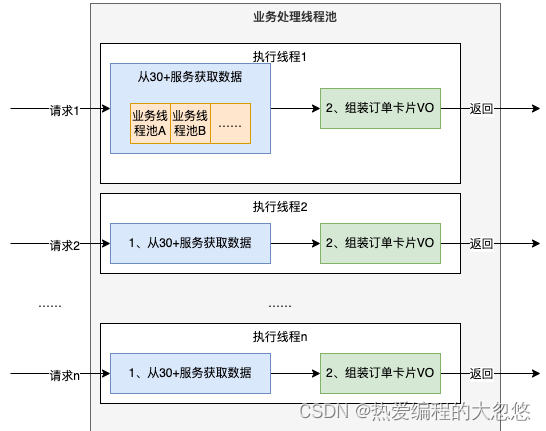
这种方式由于以下两个原因,导致资源利用率比较低:
- CPU资源大量浪费在阻塞等待上,导致CPU资源利用率低。在Java 8之前,一般会通过回调的方式来减少阻塞,但是大量使用回调,又引发臭名昭著的回调地狱问题,导致代码可读性和可维护性大大降低。
- 为了增加并发度,会引入更多额外的线程池,随着CPU调度线程数的增加,会导致更严重的资源争用,宝贵的CPU资源被损耗在上下文切换上,而且线程本身也会占用系统资源,且不能无限增加。
同步模型下,会导致硬件资源无法充分利用,系统吞吐量容易达到瓶颈。
NIO异步模型
我们主要通过以下两种方式来减少线程池的调度开销和阻塞时间:
- 通过RPC NIO异步调用的方式可以降低线程数,从而降低调度(上下文切换)开销,如Dubbo的异步调用可以参考《dubbo调用端异步》一文。
- 通过引入CompletableFuture(下文简称CF)对业务流程进行编排,降低依赖之间的阻塞。本文主要讲述CompletableFuture的使用和原理。
为什么会选择CompletableFuture?
我们首先对业界广泛流行的解决方案做了横向调研,主要包括Future、CompletableFuture注2、RxJava、Reactor。它们的特性对比如下:
| Future | CompletableFuture | RxJava | Reactor | |
|---|---|---|---|---|
| Composable(可组合) | ❌ | ✔️ | ✔️ | ✔️ |
| Asynchronous(异步) | ✔️ | ✔️ | ✔️ | ✔️ |
| Operator fusion(操作融合) | ❌ | ❌ | ✔️ | ✔️ |
| Lazy(延迟执行) | ❌ | ❌ | ✔️ | ✔️ |
| Backpressure(回压) | ❌ | ❌ | ✔️ | ✔️ |
- 可组合:可以将多个依赖操作通过不同的方式进行编排,例如CompletableFuture提供thenCompose、thenCombine等各种then开头的方法,这些方法就是对“可组合”特性的支持。
- 操作融合:将数据流中使用的多个操作符以某种方式结合起来,进而降低开销(时间、内存)。
- 延迟执行:操作不会立即执行,当收到明确指示时操作才会触发。例如Reactor只有当有订阅者订阅时,才会触发操作。
- 回压:某些异步阶段的处理速度跟不上,直接失败会导致大量数据的丢失,对业务来说是不能接受的,这时需要反馈上游生产者降低调用量。
RxJava与Reactor显然更加强大,它们提供了更多的函数调用方式,支持更多特性,但同时也带来了更大的学习成本。而我们本次整合最需要的特性就是“异步”、“可组合”,综合考虑后,我们选择了学习成本相对较低的CompletableFuture。
CompletableFuture使用与原理
CompletableFuture的背景和定义
CompletableFuture解决的问题
CompletableFuture是由Java 8引入的,在Java8之前我们一般通过Future实现异步。
- Future用于表示异步计算的结果,只能通过阻塞或者轮询的方式获取结果,而且不支持设置回调方法,Java 8之前若要设置回调一般会使用guava的ListenableFuture,回调的引入又会导致臭名昭著的回调地狱(下面的例子会通过ListenableFuture的使用来具体进行展示)。
- CompletableFuture对Future进行了扩展,可以通过设置回调的方式处理计算结果,同时也支持组合操作,支持进一步的编排,同时一定程度解决了回调地狱的问题。
下面将举例来说明,我们通过ListenableFuture、CompletableFuture来实现异步的差异。假设有三个操作step1、step2、step3存在依赖关系,其中step3的执行依赖step1和step2的结果。
Future(ListenableFuture)的实现(回调地狱)如下:
ExecutorService executor = Executors.newFixedThreadPool(5);
ListeningExecutorService guavaExecutor = MoreExecutors.listeningDecorator(executor);
ListenableFuture<String> future1 = guavaExecutor.submit(() -> {
//step 1
System.out.println("执行step 1");
return "step1 result";
});
ListenableFuture<String> future2 = guavaExecutor.submit(() -> {
//step 2
System.out.println("执行step 2");
return "step2 result";
});
ListenableFuture<List<String>> future1And2 = Futures.allAsList(future1, future2);
Futures.addCallback(future1And2, new FutureCallback<List<String>>() {
@Override
public void onSuccess(List<String> result) {
System.out.println(result);
ListenableFuture<String> future3 = guavaExecutor.submit(() -> {
System.out.println("执行step 3");
return "step3 result";
});
Futures.addCallback(future3, new FutureCallback<String>() {
@Override
public void onSuccess(String result) {
System.out.println(result);
}
@Override
public void onFailure(Throwable t) {
}
}, guavaExecutor);
}
@Override
public void onFailure(Throwable t) {
}}, guavaExecutor);- 1
- 2
- 3
- 4
- 5
- 6
- 7
- 8
- 9
- 10
- 11
- 12
- 13
- 14
- 15
- 16
- 17
- 18
- 19
- 20
- 21
- 22
- 23
- 24
- 25
- 26
- 27
- 28
- 29
- 30
- 31
- 32
- 33
- 34
- 35
CompletableFuture的实现如下:
ExecutorService executor = Executors.newFixedThreadPool(5);
CompletableFuture<String> cf1 = CompletableFuture.supplyAsync(() -> {
System.out.println("执行step 1");
return "step1 result";
}, executor);
CompletableFuture<String> cf2 = CompletableFuture.supplyAsync(() -> {
System.out.println("执行step 2");
return "step2 result";
});
cf1.thenCombine(cf2, (result1, result2) -> {
System.out.println(result1 + " , " + result2);
System.out.println("执行step 3");
return "step3 result";
}).thenAccept(result3 -> System.out.println(result3));- 1
- 2
- 3
- 4
- 5
- 6
- 7
- 8
- 9
- 10
- 11
- 12
- 13
- 14
- 15
- 16
- 17
显然,CompletableFuture的实现更为简洁,可读性更好。
CompletableFuture的定义
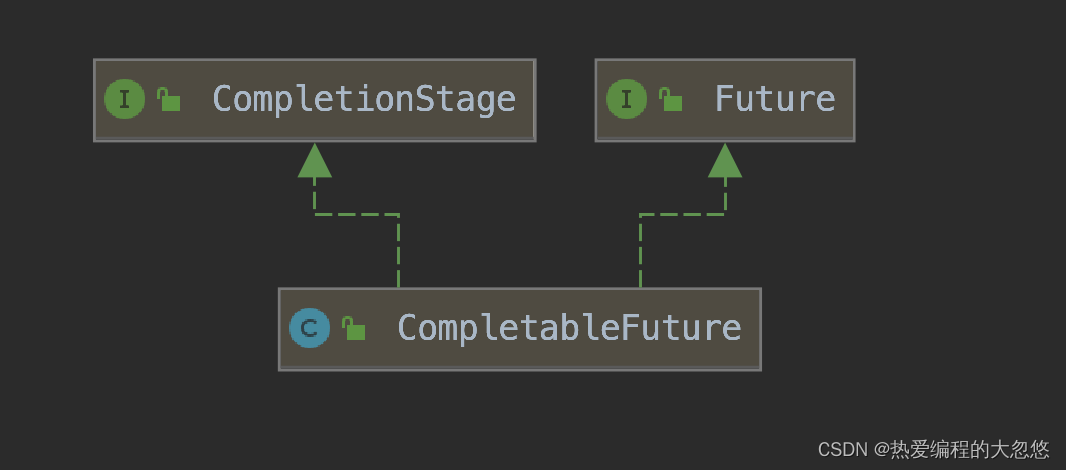
CompletableFuture实现了两个接口(如上图所示):Future、CompletionStage。
Future表示异步计算的结果。
CompletionStage用于表示异步执行过程中的一个步骤(Stage),这个步骤可能是由另外一个CompletionStage触发的,随着当前步骤的完成,也可能会触发其他一系列CompletionStage的执行。从而我们可以根据实际业务对这些步骤进行多样化的编排组合,CompletionStage接口正是定义了这样的能力,我们可以通过其提供的thenAppy、thenCompose等函数式编程方法来组合编排这些步骤。
CompletableFuture的使用
下面我们通过一个例子来讲解CompletableFuture如何使用,使用CompletableFuture也是构建依赖树的过程。一个CompletableFuture的完成会触发另外一系列依赖它的CompletableFuture的执行:
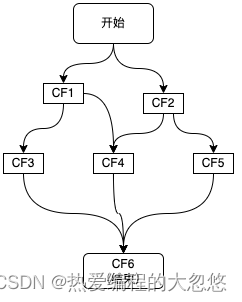
如上图所示,这里描绘的是一个业务接口的流程,其中包括CF1\CF2\CF3\CF4\CF5共5个步骤,并描绘了这些步骤之间的依赖关系,每个步骤可以是一次RPC调用、一次数据库操作或者是一次本地方法调用等,在使用CompletableFuture进行异步化编程时,图中的每个步骤都会产生一个CompletableFuture对象,最终结果也会用一个CompletableFuture来进行表示。
根据CompletableFuture依赖数量,可以分为以下几类:零依赖、一元依赖、二元依赖和多元依赖。
零依赖:CompletableFuture的创建
我们先看下如何不依赖其他CompletableFuture来创建新的CompletableFuture:
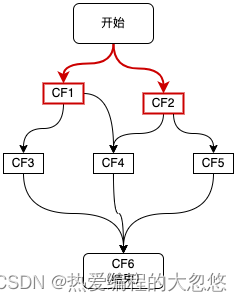
如上图红色链路所示,接口接收到请求后,首先发起两个异步调用CF1、CF2,主要有三种方式:
ExecutorService executor = Executors.newFixedThreadPool(5);
//1、使用runAsync或supplyAsync发起异步调用
CompletableFuture<String> cf1 = CompletableFuture.supplyAsync(() -> {
return "result1";
}, executor);
//2、CompletableFuture.completedFuture()直接创建一个已完成状态的CompletableFuture
CompletableFuture<String> cf2 = CompletableFuture.completedFuture("result2");
//3、先初始化一个未完成的CompletableFuture,然后通过complete()、completeExceptionally(),完成该CompletableFuture
CompletableFuture<String> cf = new CompletableFuture<>();
cf.complete("success");- 1
- 2
- 3
- 4
- 5
- 6
- 7
- 8
- 9
- 10
第三种方式的一个典型使用场景,就是将回调方法转为CompletableFuture,然后再依赖CompletableFure的能力进行调用编排,示例如下:
@FunctionalInterface
public interface ThriftAsyncCall {
void invoke() throws TException;
}
/**
* 该方法为美团内部rpc注册监听的封装,可以作为其他实现的参照
* OctoThriftCallback 为thrift回调方法
* ThriftAsyncCall 为自定义函数,用来表示一次thrift调用(定义如上)
*/
public static <T> CompletableFuture<T> toCompletableFuture(final OctoThriftCallback<?,T> callback , ThriftAsyncCall thriftCall) {
//新建一个未完成的CompletableFuture
CompletableFuture<T> resultFuture = new CompletableFuture<>();
//监听回调的完成,并且与CompletableFuture同步状态
callback.addObserver(new OctoObserver<T>() {
@Override
public void onSuccess(T t) {
resultFuture.complete(t);
}
@Override
public void onFailure(Throwable throwable) {
resultFuture.completeExceptionally(throwable);
}
});
if (thriftCall != null) {
try {
thriftCall.invoke();
} catch (TException e) {
resultFuture.completeExceptionally(e);
}
}
return resultFuture;
}- 1
- 2
- 3
- 4
- 5
- 6
- 7
- 8
- 9
- 10
- 11
- 12
- 13
- 14
- 15
- 16
- 17
- 18
- 19
- 20
- 21
- 22
- 23
- 24
- 25
- 26
- 27
- 28
- 29
- 30
- 31
- 32
一元依赖:依赖一个CF
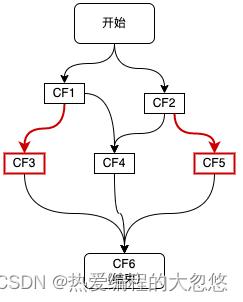
如上图红色链路所示,CF3,CF5分别依赖于CF1和CF2,这种对于单个CompletableFuture的依赖可以通过thenApply、thenAccept、thenCompose等方法来实现,代码如下所示:
CompletableFuture<String> cf3 = cf1.thenApply(result1 -> {
//result1为CF1的结果
//......
return "result3";
});
CompletableFuture<String> cf5 = cf2.thenApply(result2 -> {
//result2为CF2的结果
//......
return "result5";
});- 1
- 2
- 3
- 4
- 5
- 6
- 7
- 8
- 9
- 10
二元依赖:依赖两个CF
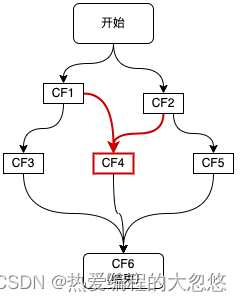
如上图红色链路所示,CF4同时依赖于两个CF1和CF2,这种二元依赖可以通过thenCombine等回调来实现,如下代码所示:
CompletableFuture<String> cf4 = cf1.thenCombine(cf2, (result1, result2) -> {
//result1和result2分别为cf1和cf2的结果
return "result4";
});- 1
- 2
- 3
- 4
多元依赖:依赖多个CF
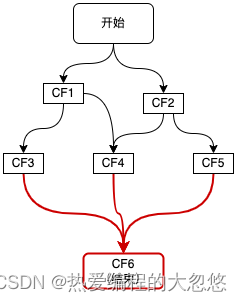
如上图红色链路所示,整个流程的结束依赖于三个步骤CF3、CF4、CF5,这种多元依赖可以通过allOf或anyOf方法来实现,区别是当需要多个依赖全部完成时使用allOf,当多个依赖中的任意一个完成即可时使用anyOf,如下代码所示:
CompletableFuture<Void> cf6 = CompletableFuture.allOf(cf3, cf4, cf5);
CompletableFuture<String> result = cf6.thenApply(v -> {
//这里的join并不会阻塞,因为传给thenApply的函数是在CF3、CF4、CF5全部完成时,才会执行 。
result3 = cf3.join();
result4 = cf4.join();
result5 = cf5.join();
//根据result3、result4、result5组装最终result;
return "result";
});- 1
- 2
- 3
- 4
- 5
- 6
- 7
- 8
- 9
CompletableFuture原理
CompletableFuture中包含两个字段:result和stack。result用于存储当前CF的结果,stack(Completion)表示当前CF完成后需要触发的依赖动作(Dependency Actions),去触发依赖它的CF的计算,依赖动作可以有多个(表示有多个依赖它的CF),以栈(Treiber stack)的形式存储,stack表示栈顶元素。

volatile Object result; // Either the result or boxed AltResult
volatile Completion stack; // Top of Treiber stack of dependent actions- 1
- 2
这种方式类似“观察者模式”,依赖动作(Dependency Action)都封装在一个单独Completion子类中。下面是Completion类关系结构图。CompletableFuture中的每个方法都对应了图中的一个Completion的子类,Completion本身是观察者的基类。
- UniCompletion继承了Completion,是一元依赖的基类,例如thenApply的实现类UniApply就继承自UniCompletion。
- BiCompletion继承了UniCompletion,是二元依赖的基类,同时也是多元依赖的基类。例如thenCombine的实现类BiRelay就继承自BiCompletion。

CompletableFuture的设计思想
按照类似“观察者模式”的设计思想,原理分析可以从“观察者”和“被观察者”两个方面着手。由于回调种类多,但结构差异不大,所以这里单以一元依赖中的thenApply为例,不再枚举全部回调类型。如下图所示:
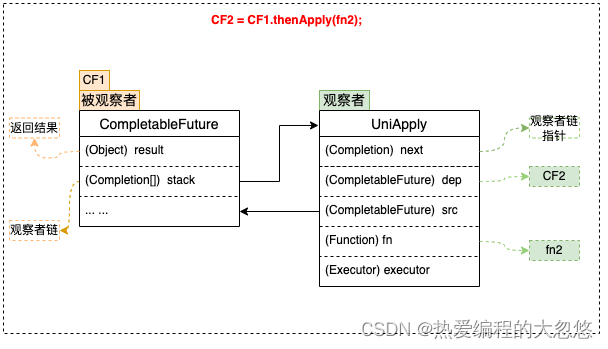
被观察者
- 每个CompletableFuture都可以被看作一个被观察者,其内部有一个Completion类型的链表成员变量stack,用来存储注册到其中的所有观察者。当被观察者执行完成后会弹栈stack属性,依次通知注册到其中的观察者。上面例子中步骤fn2就是作为观察者被封装在UniApply中。
- 被观察者CF中的result属性,用来存储返回结果数据。这里可能是一次RPC调用的返回值,也可能是任意对象,在上面的例子中对应步骤fn1的执行结果。
观察者
CompletableFuture支持很多回调方法,例如thenAccept、thenApply、exceptionally等,这些方法接收一个函数类型的参数f,生成一个Completion类型的对象(即观察者),并将入参函数f赋值给Completion的成员变量fn,然后检查当前CF是否已处于完成状态(即result != null),如果已完成直接触发fn,否则将观察者Completion加入到CF的观察者链stack中,再次尝试触发,如果被观察者未执行完则其执行完毕之后通知触发。
- 观察者中的dep属性:指向其对应的CompletableFuture,在上面的例子中dep指向CF2。
- 观察者中的src属性:指向其依赖的CompletableFuture,在上面的例子中src指向CF1。
- 观察者Completion中的fn属性:用来存储具体的等待被回调的函数。这里需要注意的是不同的回调方法(thenAccept、thenApply、exceptionally等)接收的函数类型也不同,即fn的类型有很多种,在上面的例子中fn指向fn2。
Completion类中属性定义如下:
abstract static class Completion extends ForkJoinTask<Void>
implements Runnable, AsynchronousCompletionTask {
//观察者链指针
volatile Completion next;
...- 1
- 2
- 3
- 4
- 5
UniCompletion类中属性定义如下:
abstract static class UniCompletion<T,V> extends Completion {
Executor executor; // executor to use (null if none)
CompletableFuture<V> dep; // the dependent to complete
CompletableFuture<T> src; // source for action
...- 1
- 2
- 3
- 4
- 5
整体流程
一元依赖
这里仍然以thenApply为例来说明一元依赖的流程:
- 将观察者Completion注册到CF1,此时CF1将Completion压栈。
- 当CF1的操作运行完成时,会将结果赋值给CF1中的result属性。
- 依次弹栈,通知观察者尝试运行。
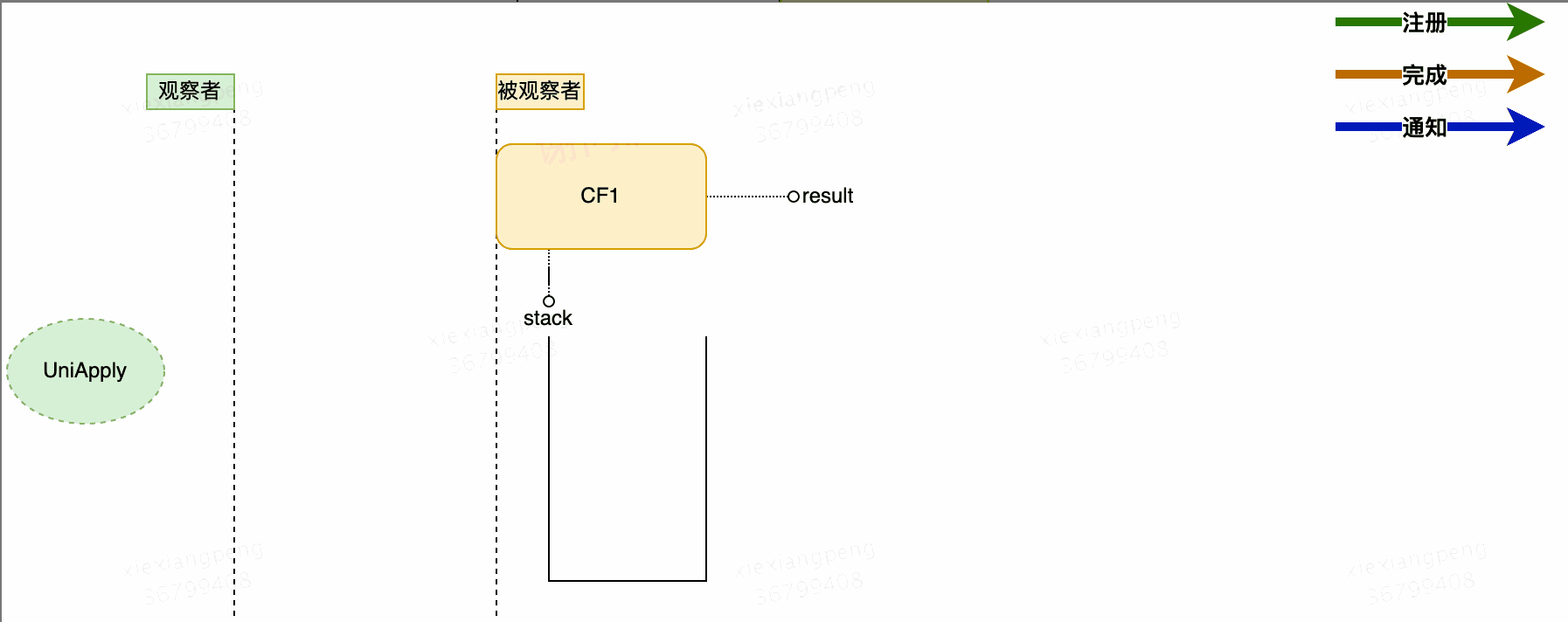
源码领读:
- 压栈过程
public <U> CompletableFuture<U> thenApply(
Function<? super T,? extends U> fn) {
//下面要执行的步骤是uniApplyStage的步骤,并且该接口并无提供指定在哪个线程池执行的能力,因此第一个参数默认为null
return uniApplyStage(null, fn);
}
private <V> CompletableFuture<V> uniApplyStage(
Executor e, Function<? super T,? extends V> f) {
//传入要执行的函数式接口不能为null
if (f == null) throw new NullPointerException();
//thenApply需要等待当前CompletableFuture的结果作为参数传给函数式接口
Object r;
//如果此时当前CompletableFuture的result属性不为空
//说明当前CompletableFuture已经有了结果
if ((r = result) != null)
//直接启动接下来的thenApply步骤即可
return uniApplyNow(r, e, f);
//new一个新的CompletableFuture---用来作为当前thenApply步骤对应的CompletableFuture
CompletableFuture<V> d = newIncompleteFuture();
//构建一个UniApply,参数: 指定的线程池(可以为null),观察者中的dep属性,观察者中的src属性,观察者Completion中的fn属性
//观察者入栈
unipush(new UniApply<T,V>(e, d, this, f));
//返回thenApply对应的CompletableFuture
return d;
}
//该方法执行说明当前CompletableFuture内部任务已经执行结束了
//r是依赖CompletableFuture的执行结果,e是线程池,f是thenApply传入要执行的任务
private <V> CompletableFuture<V> uniApplyNow(
Object r, Executor e, Function<? super T,? extends V> f) {
Throwable x;
//new一个新的CompletableFuture
CompletableFuture<V> d = newIncompleteFuture();
//依赖的CompletableFuture执行是否出现了异常
if (r instanceof AltResult) {
if ((x = ((AltResult)r).ex) != null) {
d.result = encodeThrowable(x, r);
return d;
}
r = null;
}
try {
//如果用户指定了线程池
if (e != null) {
//用指定的线程池来执行任务
e.execute(new UniApply<T,V>(null, d, this, f));
} else {
//此时thenApply方法要执行的任务是在调用thenApply方法的线程内执行的
@SuppressWarnings("unchecked") T t = (T) r;
d.result = d.encodeValue(f.apply(t));
}
} catch (Throwable ex) {
//出现异常
d.result = encodeThrowable(ex);
}
return d;
}
//观察者入栈
final void unipush(Completion c) {
if (c != null) {
//入栈成功返回true,否则返回false(存在竞争)
while (!tryPushStack(c)) {
//说明入栈失败了,在依赖的CompletableFuture结果已经出来的情况下,跳出循环
//否则继续尝试入栈
if (result != null) {
NEXT.set(c, null);
break;
}
}
//成功入栈后,需要检查此时是否已经计算出来了结果
if (result != null)
//那么此时就可以让当前thenApply的任务执行了
c.tryFire(SYNC);
}
}
//mode有三种取值:
// SYNC = 0;
// ASYNC = 1;
// NESTED = -1;
final CompletableFuture<V> tryFire(int mode) {
CompletableFuture<V> d; CompletableFuture<T> a;
Object r; Throwable x; Function<? super T,? extends V> f;
//是否满足让当前观察者运行的条件
if ((d = dep) == null || (f = fn) == null
|| (a = src) == null || (r = a.result) == null)
return null;
//d.result == null确保当前观察者对应的CompletableFuture还没有计算出结果
tryComplete: if (d.result == null) {
//虽然依赖的 CompletableFuture已经计算出结果了
//但是这个结果也有可能是因为抛出异常导致的
if (r instanceof AltResult) {
if ((x = ((AltResult)r).ex) != null) {
d.completeThrowable(x, r);
break tryComplete;
}
r = null;
}
try {
//mode大于0,说明需要采用异步执行,走入第二个分支
//claim方法内部判断用户是否指定了线程池,如果指定了直接将任务提交到线程池执行,返回false
//否则返回true
if (mode <= 0 && !claim())
//同步执行并且用户指定了线程池
return null;
else {
//mode=同步执行或者NESTED,并且用户没有指定线程池
//或者mode=异步执行
//如果此时mode=SYNC(同步执行)或NESTED,那么此时thenApply提供的任务由调用thenApply的线程执行
//如果此时mode=ASYNC(异步执行),那么此时thenApply由当前被依赖的CompletableFuture
//负责处理当前任务弹栈执行的线程调用
@SuppressWarnings("unchecked") T t = (T) r;
d.completeValue(f.apply(t));
}
} catch (Throwable ex) {
d.completeThrowable(ex);
}
}
dep = null; src = null; fn = null;
//触发任务调用后,唤醒等待着当前CompletableFuture结果的观察者们
//唤醒的前提是,当前CompletableFuture的结果已经出来了,并且栈中有等待的观察者
return d.postFire(a, mode);
}- 1
- 2
- 3
- 4
- 5
- 6
- 7
- 8
- 9
- 10
- 11
- 12
- 13
- 14
- 15
- 16
- 17
- 18
- 19
- 20
- 21
- 22
- 23
- 24
- 25
- 26
- 27
- 28
- 29
- 30
- 31
- 32
- 33
- 34
- 35
- 36
- 37
- 38
- 39
- 40
- 41
- 42
- 43
- 44
- 45
- 46
- 47
- 48
- 49
- 50
- 51
- 52
- 53
- 54
- 55
- 56
- 57
- 58
- 59
- 60
- 61
- 62
- 63
- 64
- 65
- 66
- 67
- 68
- 69
- 70
- 71
- 72
- 73
- 74
- 75
- 76
- 77
- 78
- 79
- 80
- 81
- 82
- 83
- 84
- 85
- 86
- 87
- 88
- 89
- 90
- 91
- 92
- 93
- 94
- 95
- 96
- 97
- 98
- 99
- 100
- 101
- 102
- 103
- 104
- 105
- 106
- 107
- 108
- 109
- 110
- 111
- 112
- 113
- 114
- 115
- 116
- 117
- 118
- 119
- 120
- 121
- 122
- 123
- 124
初步流程设计如上图所示,这里有几个关于注册与通知的并发问题,大家可以思考下:
Q1:在观察者注册之前,如果CF已经执行完成,并且已经发出通知,那么这时观察者由于错过了通知是不是将永远不会被触发呢 ?
A1:不会。在注册时检查依赖的CF是否已经完成。如果未完成(即result == null)则将观察者入栈,如果已完成(result != null)则直接触发观察者操作。
Q2:在”入栈“前会有”result == null“的判断,这两个操作为非原子操作,CompletableFufure的实现也没有对两个操作进行加锁,完成时间在这两个操作之间,观察者仍然得不到通知,是不是仍然无法触发?

A2:不会。入栈之后再次检查CF是否完成,如果完成则触发。
Q3:当依赖多个CF时,观察者会被压入所有依赖的CF的栈中,每个CF完成的时候都会进行,那么会不会导致一个操作被多次执行呢 ?如下图所示,即当CF1、CF2同时完成时,如何避免CF3被多次触发。
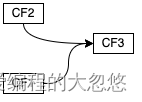
A3:CompletableFuture的实现是这样解决该问题的:观察者在执行之前会先通过CAS操作设置一个状态位,将status由0改为1。如果观察者已经执行过了,那么CAS操作将会失败,取消执行。
通过对以上3个问题的分析可以看出,CompletableFuture在处理并行问题时,全程无加锁操作,极大地提高了程序的执行效率。我们将并行问题考虑纳入之后,可以得到完善的整体流程图如下所示:
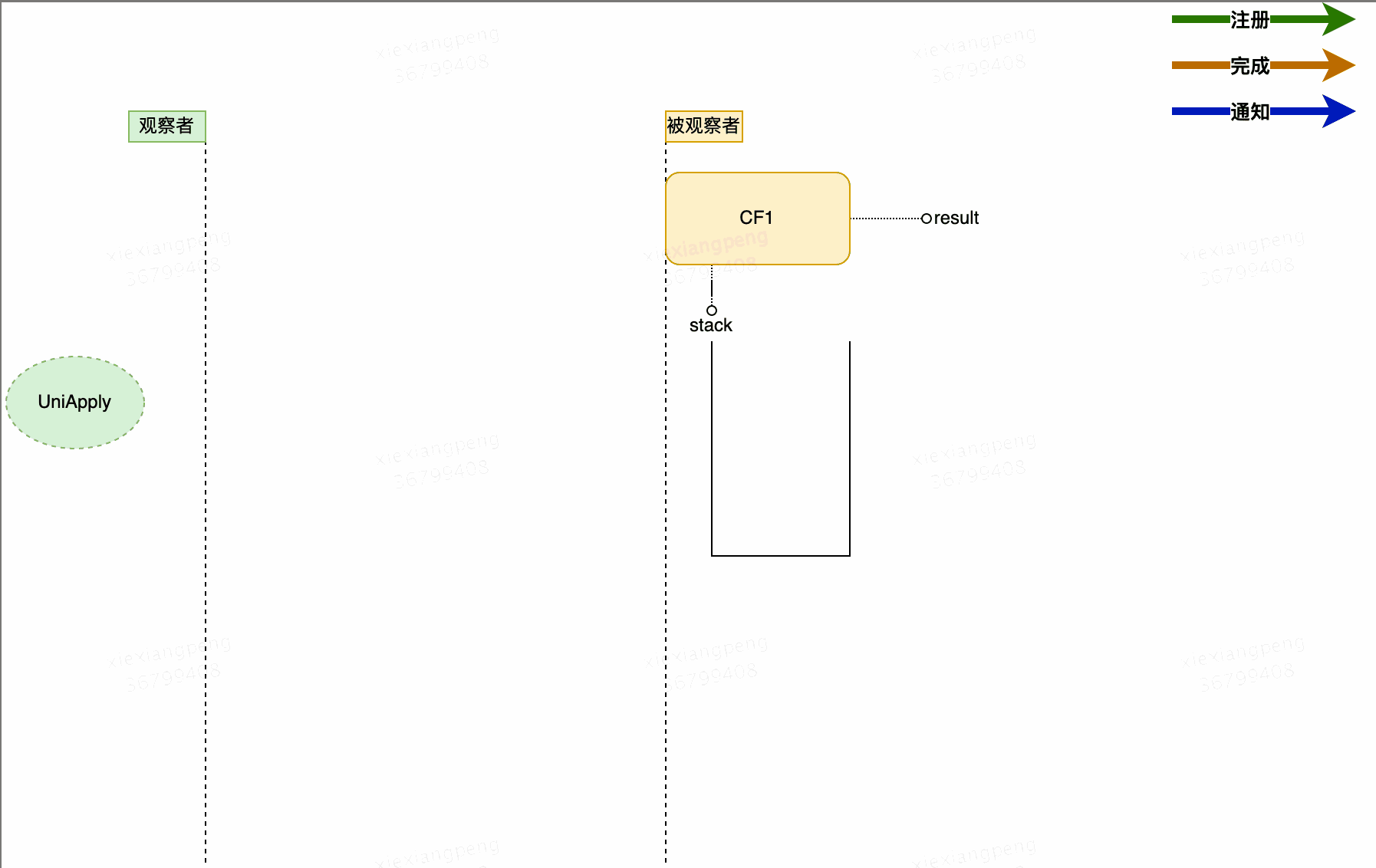
这里额外补充一下thenApplyAsync方法的执行流程:
public <U> CompletableFuture<U> thenApplyAsync(
Function<? super T,? extends U> fn) {
//使用默认提供的线程池
return uniApplyStage(defaultExecutor(), fn);
}
public Executor defaultExecutor() {
return ASYNC_POOL;
}
//可以认为,默认采用ForkJoinPool.commonPool()
private static final Executor ASYNC_POOL = USE_COMMON_POOL ?
ForkJoinPool.commonPool() : new ThreadPerTaskExecutor();- 1
- 2
- 3
- 4
- 5
- 6
- 7
- 8
- 9
- 10
- 11
- 12
- 13
VS
public <U> CompletableFuture<U> thenApply(
Function<? super T,? extends U> fn) {
//不提供任何线程池
return uniApplyStage(null, fn);
}- 1
- 2
- 3
- 4
- 5
thenApply提供的任务执行有三种可能:
- 依赖的CompletableFuture在当前thenApply任务还没入栈时就已经出来了,那么当前任务由调用thenApply方法的线程同步执行。
- 依赖的CompletableFuture在当前thenApply任务入栈成功后,立马就检测到结果已出,那么当前任务还是由thenApply方法调用。
- 依赖的CompletableFuture在当前thenApply任务入栈成功后,还是没有出来结果,那么猜测此时肯定是由依赖的CompletableFuture在结果出来后,依次弹栈唤醒观察者们,然后执行对应观察者的任务的,那么这个流程是怎么样的呢?
细节补充: 任务执行
任务执行的触发都是Completion提交的tryFire接口完成的,并且Completion 还实现了run方法,而run方法就是调用了tryFire方法而已,ASYNC作为参数传入tryFire方法。
abstract static class Completion extends ForkJoinTask<Void>
implements Runnable, AsynchronousCompletionTask {
volatile Completion next; // Treiber stack link
abstract CompletableFuture<?> tryFire(int mode);
public final void run() { tryFire(ASYNC); }
....
}- 1
- 2
- 3
- 4
- 5
- 6
- 7
- 8
- 9
tryFire方法一开始会先判断当前任务是否满足执行条件,tryFire方法源码上面已经贴出,这里再次给出一遍。
//mode有三种取值:
// SYNC = 0;
// ASYNC = 1;
// NESTED = -1;
final CompletableFuture<V> tryFire(int mode) {
CompletableFuture<V> d; CompletableFuture<T> a;
Object r; Throwable x; Function<? super T,? extends V> f;
//是否满足让当前观察者运行的条件
if ((d = dep) == null || (f = fn) == null
|| (a = src) == null || (r = a.result) == null)
return null;
//d.result == null确保当前观察者对应的CompletableFuture还没有计算出结果
tryComplete: if (d.result == null) {
//虽然依赖的 CompletableFuture已经计算出结果了
//但是这个结果也有可能是因为抛出异常导致的
if (r instanceof AltResult) {
if ((x = ((AltResult)r).ex) != null) {
d.completeThrowable(x, r);
break tryComplete;
}
r = null;
}
try {
//mode大于0,说明需要采用异步执行,走入第二个分支
//claim方法内部判断用户是否指定了线程池,如果指定了直接将任务提交到线程池执行,返回false
//否则返回true
if (mode <= 0 && !claim())
//同步执行并且用户指定了线程池
return null;
else {
//mode=同步执行或者NESTED,并且用户没有指定线程池
//或者mode=异步执行
//如果此时mode=SYNC(同步执行)或NESTED,那么此时thenApply提供的任务由调用thenApply的线程执行
//如果此时mode=ASYNC(异步执行),那么此时thenApply由当前被依赖的CompletableFuture
//负责处理当前任务弹栈执行的线程调用
@SuppressWarnings("unchecked") T t = (T) r;
d.completeValue(f.apply(t));
}
} catch (Throwable ex) {
d.completeThrowable(ex);
}
}
dep = null; src = null; fn = null;
//触发任务调用后,唤醒等待着当前CompletableFuture结果的观察者们
//唤醒的前提是,当前CompletableFuture的结果已经出来了,并且栈中有等待的观察者
return d.postFire(a, mode);
}- 1
- 2
- 3
- 4
- 5
- 6
- 7
- 8
- 9
- 10
- 11
- 12
- 13
- 14
- 15
- 16
- 17
- 18
- 19
- 20
- 21
- 22
- 23
- 24
- 25
- 26
- 27
- 28
- 29
- 30
- 31
- 32
- 33
- 34
- 35
- 36
- 37
- 38
- 39
- 40
- 41
- 42
- 43
- 44
- 45
- 46
- 47
当任务提交线程池执行,或者由调用当前tryFire方法执行后,下面需要判断当前CompletableFuture是否完成任务得出了结果,然后判断是否需要唤醒阻塞在当前CompletableFuture栈上的观察者们。
final CompletableFuture<T> postFire(CompletableFuture<?> a, int mode) {
//a是观察者中的src属性:指向其依赖的CompletableFuture
//a.stack不为空,说明依赖的CompletableFuture中还有观察者需要被唤醒
if (a != null && a.stack != null) {
Object r;
//如果a无结果,那么虽然栈不为空,那么没结果也就无需通知了,直接清空栈
if ((r = a.result) == null)
a.cleanStack();
//如果a有结果,那么进行后置处理(干啥的下面说)
if (mode >= 0 && (r != null || a.result != null))
a.postComplete();
}
//当前CompletableFuture有结果并且栈不为空
if (result != null && stack != null) {
if (mode < 0)
return this;
else
//唤醒栈中的观察者们
postComplete();
}
return null;
}- 1
- 2
- 3
- 4
- 5
- 6
- 7
- 8
- 9
- 10
- 11
- 12
- 13
- 14
- 15
- 16
- 17
- 18
- 19
- 20
- 21
- 22
final void postComplete() {
CompletableFuture<?> f = this; Completion h;
while ((h = f.stack) != null ||
(f != this && (h = (f = this).stack) != null)) {
CompletableFuture<?> d; Completion t;
if (STACK.compareAndSet(f, h, t = h.next)) {
if (t != null) {
if (f != this) {
pushStack(h);
continue;
}
NEXT.compareAndSet(h, t, null); // try to detach
}
//依次唤醒然后调用每个观察者的tryFire方法,此时参数为NESTED
f = (d = h.tryFire(NESTED)) == null ? this : d;
}
}
}- 1
- 2
- 3
- 4
- 5
- 6
- 7
- 8
- 9
- 10
- 11
- 12
- 13
- 14
- 15
- 16
- 17
- 18
上面任务执行流程分析完毕后,我们来做一个小结:

有关任务是在哪个线程被执行的,大家可以通过看流程图结合源码自己好好梳理一下,并且注意图中指向tryFire方法调用的四个不同颜色的箭头。
二元依赖
我们以thenCombine为例来说明二元依赖:
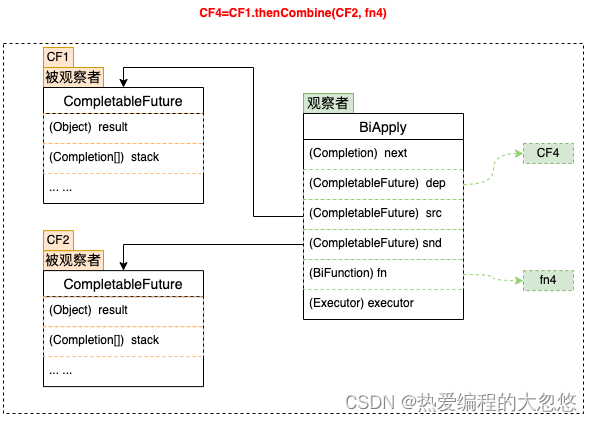
thenCombine操作表示依赖两个CompletableFuture。其观察者实现类为BiApply,如上图所示,BiApply通过src和snd两个属性关联被依赖的两个CF,fn属性的类型为BiFunction。与单个依赖不同的是,在依赖的CF未完成的情况下,thenCombine会尝试将BiApply压入这两个被依赖的CF的栈中,每个被依赖的CF完成时都会尝试触发观察者BiApply,BiApply会检查两个依赖是否都完成,如果完成则开始执行。这里为了解决重复触发的问题,同样用的是上一章节提到的CAS操作,执行时会先通过CAS设置状态位,避免重复触发。
多元依赖
依赖多个CompletableFuture的回调方法包括allOf、anyOf,区别在于allOf观察者实现类为BiRelay,需要所有被依赖的CF完成后才会执行回调;而anyOf观察者实现类为OrRelay,任意一个被依赖的CF完成后就会触发。二者的实现方式都是将多个被依赖的CF构建成一棵平衡二叉树,执行结果层层通知,直到根节点,触发回调监听。

****、
实践总结
在商家端API异步化的过程中,我们遇到了一些问题,这些问题有的会比较隐蔽,下面把这些问题的处理经验整理出来。希望能帮助到更多的同学,大家可以少踩一些坑。
线程阻塞问题
代码执行在哪个线程上?
要合理治理线程资源,最基本的前提条件就是要在写代码时,清楚地知道每一行代码都将执行在哪个线程上。下面我们看一下CompletableFuture的执行线程情况。
CompletableFuture实现了CompletionStage接口,通过丰富的回调方法,支持各种组合操作,每种组合场景都有同步和异步两种方法。
同步方法(即不带Async后缀的方法)有两种情况。
- 如果注册时被依赖的操作已经执行完成,则直接由当前线程执行。
- 如果注册时被依赖的操作还未执行完,则由回调线程执行。
异步方法(即带Async后缀的方法):可以选择是否传递线程池参数Executor运行在指定线程池中;当不传递Executor时,会使用ForkJoinPool中的共用线程池CommonPool(CommonPool的大小是CPU核数-1,如果是IO密集的应用,线程数可能成为瓶颈)。
例如:
ExecutorService threadPool1 = new ThreadPoolExecutor(10, 10, 0L, TimeUnit.MILLISECONDS, new ArrayBlockingQueue<>(100));
CompletableFuture<String> future1 = CompletableFuture.supplyAsync(() -> {
System.out.println("supplyAsync 执行线程:" + Thread.currentThread().getName());
//业务操作
return "";
}, threadPool1);
//此时,如果future1中的业务操作已经执行完毕并返回,则该thenApply直接由当前main线程执行;否则,将会由执行以上业务操作的threadPool1中的线程执行。
future1.thenApply(value -> {
System.out.println("thenApply 执行线程:" + Thread.currentThread().getName());
return value + "1";
});
//使用ForkJoinPool中的共用线程池CommonPool
future1.thenApplyAsync(value -> {
//do something
return value + "1";
});
//使用指定线程池
future1.thenApplyAsync(value -> {
//do something
return value + "1";
}, threadPool1);- 1
- 2
- 3
- 4
- 5
- 6
- 7
- 8
- 9
- 10
- 11
- 12
- 13
- 14
- 15
- 16
- 17
- 18
- 19
- 20
- 21
- 22
- 23
- 24
- 25
线程池须知
异步回调要传线程池
前面提到,异步回调方法可以选择是否传递线程池参数Executor,这里我们建议强制传线程池,且根据实际情况做线程池隔离。
当不传递线程池时,会使用ForkJoinPool中的公共线程池CommonPool,这里所有调用将共用该线程池,核心线程数=处理器数量-1(单核核心线程数为1),所有异步回调都会共用该CommonPool,核心与非核心业务都竞争同一个池中的线程,很容易成为系统瓶颈。手动传递线程池参数可以更方便的调节参数,并且可以给不同的业务分配不同的线程池,以求资源隔离,减少不同业务之间的相互干扰。
线程池循环引用会导致死锁
public Object doGet() {
ExecutorService threadPool1 = new ThreadPoolExecutor(10, 10, 0L, TimeUnit.MILLISECONDS, new ArrayBlockingQueue<>(100));
CompletableFuture cf1 = CompletableFuture.supplyAsync(() -> {
//do sth
return CompletableFuture.supplyAsync(() -> {
System.out.println("child");
return "child";
}, threadPool1).join();//子任务
}, threadPool1);
return cf1.join();
}- 1
- 2
- 3
- 4
- 5
- 6
- 7
- 8
- 9
- 10
- 11
如上代码块所示,doGet方法第三行通过supplyAsync向threadPool1请求线程,并且内部子任务又向threadPool1请求线程。threadPool1大小为10,当同一时刻有10个请求到达,则threadPool1被打满,子任务请求线程时进入阻塞队列排队,但是父任务的完成又依赖于子任务,这时由于子任务得不到线程,父任务无法完成。主线程执行cf1.join()进入阻塞状态,并且永远无法恢复。
为了修复该问题,需要将父任务与子任务做线程池隔离,两个任务请求不同的线程池,避免循环依赖导致的阻塞。
异步RPC调用注意不要阻塞IO线程池
服务异步化后很多步骤都会依赖于异步RPC调用的结果,这时需要特别注意一点,如果是使用基于NIO(比如Netty)的异步RPC,则返回结果是由IO线程负责设置的,即回调方法由IO线程触发,CompletableFuture同步回调(如thenApply、thenAccept等无Async后缀的方法)如果依赖的异步RPC调用的返回结果,那么这些同步回调将运行在IO线程上,而整个服务只有一个IO线程池,这时需要保证同步回调中不能有阻塞等耗时过长的逻辑,否则在这些逻辑执行完成前,IO线程将一直被占用,影响整个服务的响应。
其他
异常处理
由于异步执行的任务在其他线程上执行,而异常信息存储在线程栈中,因此当前线程除非阻塞等待返回结果,否则无法通过try\catch捕获异常。CompletableFuture提供了异常捕获回调exceptionally,相当于同步调用中的try\catch。使用方法如下所示:
@Autowired
private WmOrderAdditionInfoThriftService wmOrderAdditionInfoThriftService;//内部接口
public CompletableFuture<Integer> getCancelTypeAsync(long orderId) {
CompletableFuture<WmOrderOpRemarkResult> remarkResultFuture = wmOrderAdditionInfoThriftService.findOrderCancelledRemarkByOrderIdAsync(orderId);//业务方法,内部会发起异步rpc调用
return remarkResultFuture
.exceptionally(err -> {//通过exceptionally 捕获异常,打印日志并返回默认值
log.error("WmOrderRemarkService.getCancelTypeAsync Exception orderId={}", orderId, err);
return 0;
});
}- 1
- 2
- 3
- 4
- 5
- 6
- 7
- 8
- 9
- 10
有一点需要注意,CompletableFuture在回调方法中对异常进行了包装。大部分异常会封装成CompletionException后抛出,真正的异常存储在cause属性中,因此如果调用链中经过了回调方法处理那么就需要用Throwable.getCause()方法提取真正的异常。但是,有些情况下会直接返回真正的异常(Stack Overflow的讨论),最好使用工具类提取异常,如下代码所示:
@Autowired
private WmOrderAdditionInfoThriftService wmOrderAdditionInfoThriftService;//内部接口
public CompletableFuture<Integer> getCancelTypeAsync(long orderId) {
CompletableFuture<WmOrderOpRemarkResult> remarkResultFuture = wmOrderAdditionInfoThriftService.findOrderCancelledRemarkByOrderIdAsync(orderId);//业务方法,内部会发起异步rpc调用
return remarkResultFuture
.thenApply(result -> {//这里增加了一个回调方法thenApply,如果发生异常thenApply内部会通过new CompletionException(throwable) 对异常进行包装
//这里是一些业务操作
})
.exceptionally(err -> {//通过exceptionally 捕获异常,这里的err已经被thenApply包装过,因此需要通过Throwable.getCause()提取异常
log.error("WmOrderRemarkService.getCancelTypeAsync Exception orderId={}", orderId, ExceptionUtils.extractRealException(err));
return 0;
});
}- 1
- 2
- 3
- 4
- 5
- 6
- 7
- 8
- 9
- 10
- 11
- 12
- 13
上面代码中用到了一个自定义的工具类ExceptionUtils,用于CompletableFuture的异常提取,在使用CompletableFuture做异步编程时,可以直接使用该工具类处理异常。实现代码如下:
public class ExceptionUtils {
public static Throwable extractRealException(Throwable throwable) {
//这里判断异常类型是否为CompletionException、ExecutionException,如果是则进行提取,否则直接返回。
if (throwable instanceof CompletionException || throwable instanceof ExecutionException) {
if (throwable.getCause() != null) {
return throwable.getCause();
}
}
return throwable;
}
}- 1
- 2
- 3
- 4
- 5
- 6
- 7
- 8
- 9
- 10
- 11
异步化收益
通过异步化改造,美团商家端API系统的性能得到明显提升,与改造前对比的收益如下:
核心接口吞吐量大幅提升,其中订单轮询接口改造前TP99为754ms,改造后降为408ms。
服务器数量减少1/3。
名词解释及备注
注1:“增量同步”是指商家客户端与服务端之间的订单增量数据同步协议,客户端使用该协议获取新增订单以及状态发生变化的订单。
注2:本文涉及到的所有技术点依赖的Java版本为JDK 8,CompletableFuture支持的特性分析也是基于该版本。
附录
自定义函数
@FunctionalInterface
public interface ThriftAsyncCall {
void invoke() throws TException ;
}- 1
- 2
- 3
- 4
CompletableFuture处理工具类
/**
* CompletableFuture封装工具类
*/
@Slf4j
public class FutureUtils {
/**
* 该方法为美团内部rpc注册监听的封装,可以作为其他实现的参照
* OctoThriftCallback 为thrift回调方法
* ThriftAsyncCall 为自定义函数,用来表示一次thrift调用(定义如上)
*/
public static <T> CompletableFuture<T> toCompletableFuture(final OctoThriftCallback<?,T> callback , ThriftAsyncCall thriftCall) {
CompletableFuture<T> thriftResultFuture = new CompletableFuture<>();
callback.addObserver(new OctoObserver<T>() {
@Override
public void onSuccess(T t) {
thriftResultFuture.complete(t);
}
@Override
public void onFailure(Throwable throwable) {
thriftResultFuture.completeExceptionally(throwable);
}
});
if (thriftCall != null) {
try {
thriftCall.invoke();
} catch (TException e) {
thriftResultFuture.completeExceptionally(e);
}
}
return thriftResultFuture;
}
/**
* 设置CF状态为失败
*/
public static <T> CompletableFuture<T> failed(Throwable ex) {
CompletableFuture<T> completableFuture = new CompletableFuture<>();
completableFuture.completeExceptionally(ex);
return completableFuture;
}
/**
* 设置CF状态为成功
*/
public static <T> CompletableFuture<T> success(T result) {
CompletableFuture<T> completableFuture = new CompletableFuture<>();
completableFuture.complete(result);
return completableFuture;
}
/**
* 将List<CompletableFuture<T>> 转为 CompletableFuture<List<T>>
*/
public static <T> CompletableFuture<List<T>> sequence(Collection<CompletableFuture<T>> completableFutures) {
return CompletableFuture.allOf(completableFutures.toArray(new CompletableFuture<?>[0]))
.thenApply(v -> completableFutures.stream()
.map(CompletableFuture::join)
.collect(Collectors.toList())
);
}
/**
* 将List<CompletableFuture<List<T>>> 转为 CompletableFuture<List<T>>
* 多用于分页查询的场景
*/
public static <T> CompletableFuture<List<T>> sequenceList(Collection<CompletableFuture<List<T>>> completableFutures) {
return CompletableFuture.allOf(completableFutures.toArray(new CompletableFuture<?>[0]))
.thenApply(v -> completableFutures.stream()
.flatMap( listFuture -> listFuture.join().stream())
.collect(Collectors.toList())
);
}
/*
* 将List<CompletableFuture<Map<K, V>>> 转为 CompletableFuture<Map<K, V>>
* @Param mergeFunction 自定义key冲突时的merge策略
*/
public static <K, V> CompletableFuture<Map<K, V>> sequenceMap(
Collection<CompletableFuture<Map<K, V>>> completableFutures, BinaryOperator<V> mergeFunction) {
return CompletableFuture
.allOf(completableFutures.toArray(new CompletableFuture<?>[0]))
.thenApply(v -> completableFutures.stream().map(CompletableFuture::join)
.flatMap(map -> map.entrySet().stream())
.collect(Collectors.toMap(Entry::getKey, Entry::getValue, mergeFunction)));
}
/**
* 将List<CompletableFuture<T>> 转为 CompletableFuture<List<T>>,并过滤调null值
*/
public static <T> CompletableFuture<List<T>> sequenceNonNull(Collection<CompletableFuture<T>> completableFutures) {
return CompletableFuture.allOf(completableFutures.toArray(new CompletableFuture<?>[0]))
.thenApply(v -> completableFutures.stream()
.map(CompletableFuture::join)
.filter(e -> e != null)
.collect(Collectors.toList())
);
}
/**
* 将List<CompletableFuture<List<T>>> 转为 CompletableFuture<List<T>>,并过滤调null值
* 多用于分页查询的场景
*/
public static <T> CompletableFuture<List<T>> sequenceListNonNull(Collection<CompletableFuture<List<T>>> completableFutures) {
return CompletableFuture.allOf(completableFutures.toArray(new CompletableFuture<?>[0]))
.thenApply(v -> completableFutures.stream()
.flatMap( listFuture -> listFuture.join().stream().filter(e -> e != null))
.collect(Collectors.toList())
);
}
/**
* 将List<CompletableFuture<Map<K, V>>> 转为 CompletableFuture<Map<K, V>>
* @Param filterFunction 自定义过滤策略
*/
public static <T> CompletableFuture<List<T>> sequence(Collection<CompletableFuture<T>> completableFutures,
Predicate<? super T> filterFunction) {
return CompletableFuture.allOf(completableFutures.toArray(new CompletableFuture<?>[0]))
.thenApply(v -> completableFutures.stream()
.map(CompletableFuture::join)
.filter(filterFunction)
.collect(Collectors.toList())
);
}
/**
* 将List<CompletableFuture<List<T>>> 转为 CompletableFuture<List<T>>
* @Param filterFunction 自定义过滤策略
*/
public static <T> CompletableFuture<List<T>> sequenceList(Collection<CompletableFuture<List<T>>> completableFutures,
Predicate<? super T> filterFunction) {
return CompletableFuture.allOf(completableFutures.toArray(new CompletableFuture<?>[0]))
.thenApply(v -> completableFutures.stream()
.flatMap( listFuture -> listFuture.join().stream().filter(filterFunction))
.collect(Collectors.toList())
);
}
/**
* 将CompletableFuture<Map<K,V>>的list转为 CompletableFuture<Map<K,V>>。 多个map合并为一个map。 如果key冲突,采用新的value覆盖。
*/
public static <K, V> CompletableFuture<Map<K, V>> sequenceMap(
Collection<CompletableFuture<Map<K, V>>> completableFutures) {
return CompletableFuture
.allOf(completableFutures.toArray(new CompletableFuture<?>[0]))
.thenApply(v -> completableFutures.stream().map(CompletableFuture::join)
.flatMap(map -> map.entrySet().stream())
.collect(Collectors.toMap(Entry::getKey, Entry::getValue, (a, b) -> b)));
}}- 1
- 2
- 3
- 4
- 5
- 6
- 7
- 8
- 9
- 10
- 11
- 12
- 13
- 14
- 15
- 16
- 17
- 18
- 19
- 20
- 21
- 22
- 23
- 24
- 25
- 26
- 27
- 28
- 29
- 30
- 31
- 32
- 33
- 34
- 35
- 36
- 37
- 38
- 39
- 40
- 41
- 42
- 43
- 44
- 45
- 46
- 47
- 48
- 49
- 50
- 51
- 52
- 53
- 54
- 55
- 56
- 57
- 58
- 59
- 60
- 61
- 62
- 63
- 64
- 65
- 66
- 67
- 68
- 69
- 70
- 71
- 72
- 73
- 74
- 75
- 76
- 77
- 78
- 79
- 80
- 81
- 82
- 83
- 84
- 85
- 86
- 87
- 88
- 89
- 90
- 91
- 92
- 93
- 94
- 95
- 96
- 97
- 98
- 99
- 100
- 101
- 102
- 103
- 104
- 105
- 106
- 107
- 108
- 109
- 110
- 111
- 112
- 113
- 114
- 115
- 116
- 117
- 118
- 119
- 120
- 121
- 122
- 123
- 124
- 125
- 126
- 127
- 128
- 129
- 130
- 131
- 132
- 133
- 134
- 135
- 136
- 137
- 138
异常提取工具类
public class ExceptionUtils {
/**
* 提取真正的异常
*/
public static Throwable extractRealException(Throwable throwable) {
if (throwable instanceof CompletionException || throwable instanceof ExecutionException) {
if (throwable.getCause() != null) {
return throwable.getCause();
}
}
return throwable;
}
}- 1
- 2
- 3
- 4
- 5
- 6
- 7
- 8
- 9
- 10
- 11
- 12
- 13
打印日志
@Slf4j
public abstract class AbstractLogAction<R> {
protected final String methodName;
protected final Object[] args;
public AbstractLogAction(String methodName, Object... args) {
this.methodName = methodName;
this.args = args;
}
protected void logResult(R result, Throwable throwable) {
if (throwable != null) {
boolean isBusinessError = throwable instanceof TBase || (throwable.getCause() != null && throwable
.getCause() instanceof TBase);
if (isBusinessError) {
logBusinessError(throwable);
} else if (throwable instanceof DegradeException || throwable instanceof DegradeRuntimeException) {//这里为内部rpc框架抛出的异常,使用时可以酌情修改
if (RhinoSwitch.getBoolean("isPrintDegradeLog", false)) {
log.error("{} degrade exception, param:{} , error:{}", methodName, args, throwable);
}
} else {
log.error("{} unknown error, param:{} , error:{}", methodName, args, ExceptionUtils.extractRealException(throwable));
}
} else {
if (isLogResult()) {
log.info("{} param:{} , result:{}", methodName, args, result);
} else {
log.info("{} param:{}", methodName, args);
}
}
}
private void logBusinessError(Throwable throwable) {
log.error("{} business error, param:{} , error:{}", methodName, args, throwable.toString(), ExceptionUtils.extractRealException(throwable));
}
private boolean isLogResult() {
//这里是动态配置开关,用于动态控制日志打印,开源动态配置中心可以使用nacos、apollo等,如果项目没有使用配置中心则可以删除
return RhinoSwitch.getBoolean(methodName + "_isLogResult", false);
}}- 1
- 2
- 3
- 4
- 5
- 6
- 7
- 8
- 9
- 10
- 11
- 12
- 13
- 14
- 15
- 16
- 17
- 18
- 19
- 20
- 21
- 22
- 23
- 24
- 25
- 26
- 27
- 28
- 29
- 30
- 31
- 32
- 33
- 34
- 35
- 36
日志处理实现类
/**
* 发生异常时,根据是否为业务异常打印日志。
* 跟CompletableFuture.whenComplete配合使用,不改变completableFuture的结果(正常OR异常)
*/
@Slf4j
public class LogErrorAction<R> extends AbstractLogAction<R> implements BiConsumer<R, Throwable> {
public LogErrorAction(String methodName, Object... args) {
super(methodName, args);
}
@Override
public void accept(R result, Throwable throwable) {
logResult(result, throwable);
}
}- 1
- 2
- 3
- 4
- 5
- 6
- 7
- 8
- 9
- 10
- 11
- 12
- 13
- 14
打印日志方式
completableFuture
.whenComplete(
new LogErrorAction<>("orderService.getOrder", params));- 1
- 2
- 3
异常情况返回默认值
/**
* 当发生异常时返回自定义的值
*/
public class DefaultValueHandle<R> extends AbstractLogAction<R> implements BiFunction<R, Throwable, R> {
private final R defaultValue;
/**
* 当返回值为空的时候是否替换为默认值
*/
private final boolean isNullToDefault;
/**
* @param methodName 方法名称
* @param defaultValue 当异常发生时自定义返回的默认值
* @param args 方法入参
*/
public DefaultValueHandle(String methodName, R defaultValue, Object... args) {
super(methodName, args);
this.defaultValue = defaultValue;
this.isNullToDefault = false;
}
/**
* @param isNullToDefault
* @param defaultValue 当异常发生时自定义返回的默认值
* @param methodName 方法名称
* @param args 方法入参
*/
public DefaultValueHandle(boolean isNullToDefault, R defaultValue, String methodName, Object... args) {
super(methodName, args);
this.defaultValue = defaultValue;
this.isNullToDefault = isNullToDefault;
}
@Override
public R apply(R result, Throwable throwable) {
logResult(result, throwable);
if (throwable != null) {
return defaultValue;
}
if (result == null && isNullToDefault) {
return defaultValue;
}
return result;
}
public static <R> DefaultValueHandle.DefaultValueHandleBuilder<R> builder() {
return new DefaultValueHandle.DefaultValueHandleBuilder<>();
}
public static class DefaultValueHandleBuilder<R> {
private boolean isNullToDefault;
private R defaultValue;
private String methodName;
private Object[] args;
DefaultValueHandleBuilder() {
}
public DefaultValueHandle.DefaultValueHandleBuilder<R> isNullToDefault(final boolean isNullToDefault) {
this.isNullToDefault = isNullToDefault;
return this;
}
public DefaultValueHandle.DefaultValueHandleBuilder<R> defaultValue(final R defaultValue) {
this.defaultValue = defaultValue;
return this;
}
public DefaultValueHandle.DefaultValueHandleBuilder<R> methodName(final String methodName) {
this.methodName = methodName;
return this;
}
public DefaultValueHandle.DefaultValueHandleBuilder<R> args(final Object... args) {
this.args = args;
return this;
}
public DefaultValueHandle<R> build() {
return new DefaultValueHandle<R>(this.isNullToDefault, this.defaultValue, this.methodName, this.args);
}
public String toString() {
return "DefaultValueHandle.DefaultValueHandleBuilder(isNullToDefault=" + this.isNullToDefault + ", defaultValue=" + this.defaultValue + ", methodName=" + this.methodName + ", args=" + Arrays.deepToString(this.args) + ")";
}
}- 1
- 2
- 3
- 4
- 5
- 6
- 7
- 8
- 9
- 10
- 11
- 12
- 13
- 14
- 15
- 16
- 17
- 18
- 19
- 20
- 21
- 22
- 23
- 24
- 25
- 26
- 27
- 28
- 29
- 30
- 31
- 32
- 33
- 34
- 35
- 36
- 37
- 38
- 39
- 40
- 41
- 42
- 43
- 44
- 45
- 46
- 47
- 48
- 49
- 50
- 51
- 52
- 53
- 54
- 55
- 56
- 57
- 58
- 59
- 60
- 61
- 62
- 63
- 64
- 65
- 66
- 67
- 68
- 69
- 70
- 71
- 72
- 73
- 74
默认返回值应用示例
completableFuture.handle(new DefaultValueHandle<>("orderService.getOrder", Collections.emptyMap(), params));- 1
总结
本篇文章转载至CompletableFuture原理与实践-外卖商家端API的异步化,在该文的基础上,添加了一些额外源码解析和流程图分析,希望能够帮助大家更加细节理解CompletableFuture的实现。
